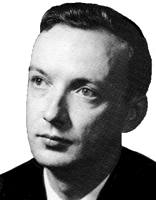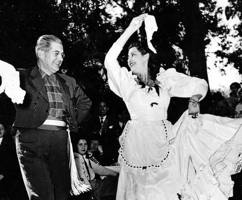
|
The Society of Folk Dance Historians (SFDH)
Folk Dances of Cono Sur
[
Home |
About |
Encyclopedia | CLICK AN IMAGE TO ENLARGE |

|
 The Spanish phrase Cono Sur (Southern Cone) refers to the countries of Argentina, Chile, Paraguay, and Uruguay taken as a regional unit. It's a useful, apt expression, since these countries share a large number of cultural traits, including sizable portions of their folk music and traditional dance replertoires.
The Spanish phrase Cono Sur (Southern Cone) refers to the countries of Argentina, Chile, Paraguay, and Uruguay taken as a regional unit. It's a useful, apt expression, since these countries share a large number of cultural traits, including sizable portions of their folk music and traditional dance replertoires.
There is little trace of the dances of the orignal Indians of the area, although a few vestiges of social and ritual dances survive in extreme southern and northern Chile, the Andean regions of Argentina near the Peruvian and Bolivian borders, and in Paraguay. African elements, so important in the dances further north in the Western Hemisphere, play a relatively minor role in these countries.
For the most part, what people of the Southern Cone today refer to as their "folk" or "traditional" dances are the social dances that were popular in their countries during the 17th, 18th, and 19th centuries. Since these are all but extinct nowadays, having been superseded by the social dances of this century, they are often called "historical dances." They include the Americanized descendents of dance brought mostly from Spain and France. Very few dances are said to have been totally "created" in the regions we're dealing with here, but the old imports have been so changed by the natives to fit their own New-World temperament and conditions as to produce what amount to independent forms.
 The repertoire consists roughly of a hundred dances, only a handful of which are still spontaneously danced today. Almost all are couple dances. These in turn can be divided into "non-contact" dances (flirtatious dances in which partners never touch) and "contact" dances (in which partners take various ballroom positions).
The repertoire consists roughly of a hundred dances, only a handful of which are still spontaneously danced today. Almost all are couple dances. These in turn can be divided into "non-contact" dances (flirtatious dances in which partners never touch) and "contact" dances (in which partners take various ballroom positions).
The non-contact couple dances are the oldest. Some of the best known are Cueca (considered by Chileans to be their national dance, but also danced in Argentina), the Zamba (primarily Argentina), the Gato (known at various times throughout the Southern Cone), and the Chacarera.
Partners trace circles around each other, advance toward each other and retire, turn or dane in place facing each other, etc., sometimes in an improvised way or, depending on the particular dance, following set sequences. For example, in the Argentine gato, the man and woman begin facing each other, then trace a full circle counterclockwise (vuelta), returning home where each does a small circle in place (giro), then the man does a zapateo (combination of stamps and heel-and-toe taps in place) while the woman traces small curved paths more or less in place, swinging her skirt and continuously facing him (zarandeo). Then each does a half circle (media vuelta) ending up in the partner's place, where the zapateo-zarandeo figure is repeated. They end advancing toward each other with a turn and as the music ends they face in a pose with arms raised, just short of an embrace (coronación). They separate during a brief musical interlude, then, as one of the musicians shouts "¡Y se val la segunda! (Here goes the second), they repeat the entire dance from opposite positions. The travelling step used throughout is a smooth, deliberate step-together-step in 6/8 meter.
The most important of the contact dances are the Cielito and its offspring, the Media cana and the Pericon, all descended from European contradanzas and quadrilles. Like our United States contra and square dances, they involved couples interacting in longways and square formations, and were prompted by a caller known as the bactonero. Usually in waltz time, they contain familiar figures such as promenade, right-hand star, ladies chain, grand right and left, etc. While their figures remained relatively stable (the bactonero did not have as much creative leeway as an American square dance caller), they had some intriguing features, such as meter and tempo changes in the middle of the dance (shifts from a moderato waltz tempo to a quick, insistent 6/8 Gato rhythm, then to a slower, more lyrical Zamba, and finally a return to the waltz).
Around the turn of the century, before its folk form declined, the Pericon, the most elaborate of these dances, became popular as a stage number in vaudeville and circus shows. One version reported in 1910 had seventy figures! Today, it is considered Uruguay's national dance, and is performed at any public event having a patriotic theme; it always ends with the dancers forming a huge "star" figure (the pabellon or "national colors") with their alternating blue and white kerchiefs.
The standard "international" 19th-century social dances such as the waltz (vale), polka (polca), schottisch (chotía), and mazurka (mazurca) were widespread in the Southern Cone. In Paraguay, an intriguing syncopated polka style in 6/8 meter [Danza Paraguaya] is considered by some to be that country's national dance.
Rapid-fire heel-and-toe taps and shuffles in a driving TA-ta-ta-ta-ta-TA rhythm, with knees constantly bent, the body in a casual semi-slouch and arms dangling at the sides – these are the characteristics of the gaucho's famous solo dance, the Malambo. Toward the end of the last century it could be seen at campfire gatherings and in pampa pulperias (taverns), performed either as a lone virtuoso display or as a competition dance by two or more men.
The Malambo consisted of a series of figures called madanzas (changes), done first starting with the right foot, then immediately repeated with the other foot (in mirror image) and increasing in intricacy. A true master malambieta did not remove his spurs when he danced; and sometimes he tied sharp knives to his boots to further demonstrate his agility.
Most of the old dances are being preserved in standardized forms (sometimes reconstructed) by numerous folk dance groups, societies, academies, and individual teachers. And, although no "National Folk Dance Ensemble" on a par with the Mexican ballete folklóricos have emerged, choreographers and dramatists often include stylized local folk dances as part of their theatrical works.
A dozen or so folk dances from Chile, Argentina, and Uruguay have been presented in the United States at various times and places, including Stockton Folk Dance Camp and Folk Dance House in New York. That they have not become more popular among folk dancers in this country is something of a mystery to me; the music, especially, is charming and rhythmical, the steps range the entire scale of difficulty, from the relatively simple travelling steps to the intriguing, tricky zapateos. Maybe we do need a big "Southern Cone State Folk Ensemble" nationwide tour to turn us on!
DOCUMENTS
Printed in Folk Dance Scene, September 1984.
This page © 2018 by Ron Houston.
Please do not copy any part of this page without including this copyright notice.
Please do not copy small portions out of context.
Please do not copy large portions without permission from Ron Houston.